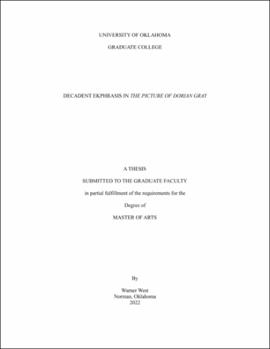| dc.contributor.advisor | Sider, Justin | |
| dc.contributor.author | West, Warner | |
| dc.date.accessioned | 2022-12-12T15:35:10Z | |
| dc.date.available | 2022-12-12T15:35:10Z | |
| dc.date.issued | 2022-12-16 | |
| dc.identifier.uri | https://hdl.handle.net/11244/336919 | |
| dc.description.abstract | Oscar Wilde’s The Picture of Dorian Gray, as a novel about aesthetes and decadent artists, has several acts of ekphrasis, the process by which visual art is detailed using a verbal description. Unlike the traditional use of ekphrasis, Wilde tends to leap past the surface of the portraits in his novel and ponder the hidden depths of the painting’s subjects. This mode of ekphrasis contains a gap between the actual depiction in the portrait and the affective response of the viewer and has its roots in the work of Wilde’s mentor, Walter Pater. Pater believes that personality and emotional suggestiveness are what matter most in art, so his own ekphrases reflect these beliefs. This often requires a leap between what is seen on the surface to what is suspected in the depths in a manner similar to W.J.T. Mitchell’s description of ekphrasis as a project about overcoming difference. Though Wilde uses this form of ekphrasis, his novel shows by the deaths of Dorian Gray and Sybil Vane that there is something wrong or dangerous about it. This study looks at this type of ekphrasis in Wilde’s novel and how he critiques this mode. | en_US |
| dc.language | en_US | en_US |
| dc.subject | Decadence | en_US |
| dc.subject | Oscar Wilde | en_US |
| dc.subject | The Picture of Dorian Gray | en_US |
| dc.subject | Ekphrasis | en_US |
| dc.title | Decadent Ekphrasis in The Picture of Dorian Gray | en_US |
| dc.contributor.committeeMember | Zeigler, James | |
| dc.contributor.committeeMember | Garofalo, Daniela | |
| dc.date.manuscript | 2022-12-02 | |
| dc.thesis.degree | Master of Arts | en_US |
| ou.group | Dodge Family College of Arts and Sciences::Department of English | en_US |
